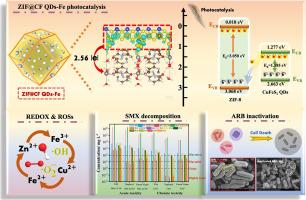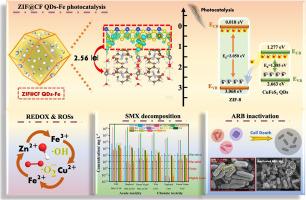量子点修饰金属-有机骨架的界面结构:电荷转移机制、抗生素相关污染物的光降解和生态毒性预测
IF 12.4
1区 环境科学与生态学
Q1 ENGINEERING, ENVIRONMENTAL
引用次数: 0
摘要
金属有机骨架(MOFs)光催化剂的光收集和界面形貌对抑制抗生素耐药性具有重要意义。本文建立了Z-scheme ZIF-8@CuFeS2量子点(ZIF@CF QDs)的混合界面,该界面对抗生素相关污染物具有优异的光降解性能。具体来说,ZIF@CF QDs-Fe3O4 (ZIF@CF QDs-Fe)磁异质结在90分钟内(k=0.04496 min⁻¹)实现了磺胺甲氧唑(SMX) 90.27%的还原,在6小时内实现了抗生素耐药菌(ARB) 5.99 lg和sul1 4.57 lg的失活。值得注意的是,通过密度泛函理论(DFT)计算研究了异质结的内置电场,增强了ZIF@CF QDs-Fe光激活过程中的电荷迁移。此外,在ZIF@CF QDs-Fe的电子路径中,自由基(·O₂⁻和·OH)的光生成和金属离子(Zn2+, Fe2+/Fe3+, Cu2+)之间的氧化还原循环得到加强。此外,其可重复性和生态毒性抑制作用保证了其在生态光修复中的稳定应用。因此,该研究为纳米光催化的发展提供了机会,在实际处理中具有光转化和废水净化的协同作用。本文章由计算机程序翻译,如有差异,请以英文原文为准。


Interfacial architecture on quantum dots modified metal-organic frameworks: Charge transfer mechanism, antibiotic associated pollutants photodegradation and eco-toxicity prediction
The light harvesting and interfacial morphology of metal-organic framework (MOFs) based photocatalyst poses great significance for antibiotic resistance inhibition. Herein, the hybrid interface of the Z-scheme ZIF-8@CuFeS2 quantum dots (ZIF@CF QDs) was established, which exhibited superior photodegradation performance for antibiotic associated pollutants. Specifically, ZIF@CF QDs-Fe3O4 (ZIF@CF QDs-Fe) magnetic heterojunction achieved 90.27 % reduction of sulfamethoxazole (SMX) within 90 min (k=0.04496 min⁻¹), 5.99 lg inactivation of antibiotic resistant bacteria (ARB) and 4.57 lg of sul1 achieved within 6h. Notably, the built-in electric field of heterojunction was investigated via density functional theory (DFT) calculation, enhancing the charge migration during ZIF@CF QDs-Fe photoactivation. Furthermore, the radicals (·O₂⁻ and ·OH) photogeneration and redox cycles between metal ions (Zn2+, Fe2+/Fe3+, Cu2+) were strengthened in electronic path of ZIF@CF QDs-Fe. Besides, the repeatability and eco-toxicity inhibition guaranteed stable application in ecological photo-remediation. Hence, this study proposed an opportunity for nano-photocatalytic development, synergistically promising the light-conversion and wastewater purification in practical treatment.
求助全文
通过发布文献求助,成功后即可免费获取论文全文。
去求助
来源期刊

Water Research
环境科学-工程:环境
CiteScore
20.80
自引率
9.40%
发文量
1307
审稿时长
38 days
期刊介绍:
Water Research, along with its open access companion journal Water Research X, serves as a platform for publishing original research papers covering various aspects of the science and technology related to the anthropogenic water cycle, water quality, and its management worldwide. The audience targeted by the journal comprises biologists, chemical engineers, chemists, civil engineers, environmental engineers, limnologists, and microbiologists. The scope of the journal include:
•Treatment processes for water and wastewaters (municipal, agricultural, industrial, and on-site treatment), including resource recovery and residuals management;
•Urban hydrology including sewer systems, stormwater management, and green infrastructure;
•Drinking water treatment and distribution;
•Potable and non-potable water reuse;
•Sanitation, public health, and risk assessment;
•Anaerobic digestion, solid and hazardous waste management, including source characterization and the effects and control of leachates and gaseous emissions;
•Contaminants (chemical, microbial, anthropogenic particles such as nanoparticles or microplastics) and related water quality sensing, monitoring, fate, and assessment;
•Anthropogenic impacts on inland, tidal, coastal and urban waters, focusing on surface and ground waters, and point and non-point sources of pollution;
•Environmental restoration, linked to surface water, groundwater and groundwater remediation;
•Analysis of the interfaces between sediments and water, and between water and atmosphere, focusing specifically on anthropogenic impacts;
•Mathematical modelling, systems analysis, machine learning, and beneficial use of big data related to the anthropogenic water cycle;
•Socio-economic, policy, and regulations studies.
 求助内容:
求助内容: 应助结果提醒方式:
应助结果提醒方式:


